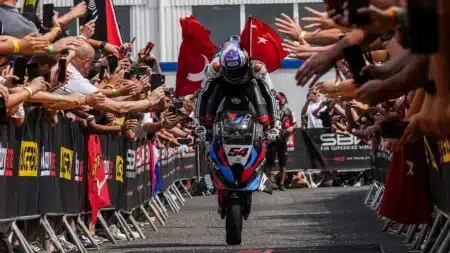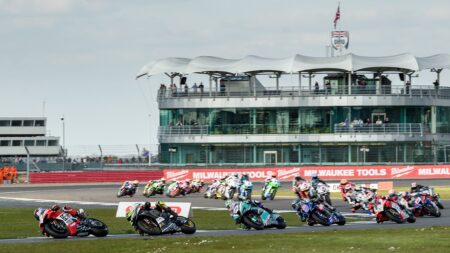Frank Perris was a star of the early days of GP racing. Now, on the eve of the 68th season of GP racing, it’s time to pay tribute

Frank Perris was a top Grand Prix rider of the early 1960s, when motorcycling’s World Championships were still brand new. This blog marks the first anniversary of his death, last March.
Perris rode a Norton Manx 500cc single to third in the 1961 500 World Championship, behind the MV Agustas of Mike Hailwood and Gary Hocking, which is a bit like finishing third in the 2016 MotoGP series aboard a Triumph Street Triple.
He raced in very different times: medieval-looking bikes, bowel-loosening street circuits and a lifestyle that would have most modern day MotoGP gladiators scratching their heads in bewilderment.
Although he later won several 125 GPs, Perris never won a round of the premier-class world championship. He came closest at the 1961 Argentine GP (bike racing’s very first flyaway), which went unattended by Hailwood and Hocking, no doubt already sunning themselves on a beach somewhere, having already secured the top two places in the championship.
Perris led the race at Buenos Aires on his Manx, then a footrest fell off, then the gear linkage fell off, leaving him stuck in third gear. The big single’s torque allowed him to limp home in third place, which secured him that top-three championship finish.
Perris and his wife Rita were a huge help to me when I wrote Stealing Speed, which tells the James Bond-style tale of Cold War racing intrigue in which GP rider Ernst Degner defects from East to West and from MZ to Suzuki, taking Walter Kaaden’s two-stroke secrets to Japan, thereby setting the scene for the next four decades of GP racing.
Buy a copy of Mat’s book Stealing Speed here.
The couple were good friends with Degner and were in the midst of his defection, following a boozy knees-up at the 1961 Swedish GP. While I interviewed them at their home they showed me their scrapbooks which reveal a way of racing life long gone that also should not be forgotten.
When he started in 1951, Perris raced around disused Second World War airfields, sleeping in Nissen huts where RAF pilots had slept only a few years earlier. He may have owed his life to a minor prang at bomber base Silverstone that left him with a broken wrist. He was doing his army national service at the time and was due for embarkation to the Korean War. The injury kept him home in Britain.

Crossing the channel before roll-on/roll-off ferries
Perris made his European racing debut in the 1950s at Monza on a KTT Velocette, which he had ridden all the way from home. That ride was an adventure he would never forget. Later expeditions were made in a tiny pick-up – bikes extending out onto the tailgate – which was lifted onto the channel ferry by a huge dockyard crane. No roll-on/roll-off ferries in those days.
When he went pro he shifted up a gear: Frank and Rita travelled abroad in a Morris Minor 1000, towing a small box trailer that had belonged to a florist. Inside went a 350 Manx and a 500 Manx, the standard privateer’s stable of the time. When the couple stopped en route to make camp they pulled off the road, took the bikes out of the trailer and slept inside. Rita did great work transforming the interior: wallpaper, dummy curtains, the lot. They cooked on a single-ring camping stove.

Rita cooking up a storm in the ex-florist’s trailer.
They were always on the road, racing on the streets of one European town one weekend earning enough money to get them to the next, like circus gypsies.
Only very occasionally did Perris not have to race between walls and buildings, like at the Salzburg International staged on a section of autobahn outside the city. The circuit was straightforward: riders raced down the autobahn, did a U-turn at the end, raced down the other side and did another U-turn. The only complication was the part-cobblestone track surface.

Perris (59) push starts his Manx at Salzberg.
Halfway through 1961 Perris got a factory 125 ride with Suzuki. His contract was worth £1100, paid in cash. When he got home to his flat in Penge, South East London, he and Rita laid the bank notes across the floor and rolled in the money. Then he went and celebrated by buying a tiny caravan.
At that time Suzuki was the joke of the paddock because its bikes were both slow and prone to sudden seizures, which is why it paid Degner to defect from MZ. The seizures often catapulted Suzuki’s hapless riders onto the tarmac or into a wall, so Perris developed gunslinger reactions in an effort to stay alive, while also keeping four fingers hovering over the clutch and using the thumb to hang onto the handlebar. He was into his seventies before the enormous callus that developed on the thumb had disappeared.
Despite his tricks, Perris suffered many injuries from being flung down the road by those wicked two-strokes. He told me of one particular weekend at the 1962 French Grand Prix, staged at the 14-mile Clermont-Ferrand circuit that twisted and turned around an extinct volcano. He had already been hurled to the ground twice during practice when his 125 seized again, flinging him off a third time. Battered and bruised, he began the long walk back to paddock, alongside fellow Brit Rex Avery, whose EMC had done exactly the same thing to him.
On their walk they met Dr Joe Ehrlich (EMC stands for Ehrlich Motor Cycles) who put his hand in his coat pocket and brought out a bottle of whisky. By the time Perris and Avery got back to the paddock they were, in his words, “absolutely pissed”. The Suzuki staff weren’t happy about that, even though the riders could surely be forgiven for wanting to anaesthetise their shot-to-pieces nerves. When I asked Perris why he kept getting back on a machine that could end his life at any moment, he grinned and said, “the money was good!”.
Perris survived those early two-stroke days, but only just. His worst prang came at Daytona in 1964, as he rocketed around the banking on Suzuki’s 170mph four-cylinder 250, the bike the riders nicknamed ‘Whispering Death’. Sure enough, the engine seized at 140mph, flinging him over the top and leaving with a very badly smashed leg. The same thing happened at Spa, bike racing’s most lethal track after the Isle of Man TT.
“The 250 had a fearsome reputation,” Perris told me. “It had such a narrow powerband and the power would come in with a bang, so you had to be awfully careful. And it used to seize up on you very, very quick. You could usually catch the 125 twin, something would tell you it was going to seize, but the 250 wasn’t so easy. It did pistons and big ends – the piston seizures you could catch, but big ends were much worse. You’d be flat on the tank at Spa, doing 150mph and it’d go bang! Oh God, oh bloody hell! They just couldn’t stop it seizing. It used to seize every race, either in the race or in practice.”
Perris was a gent – he called his pudding-basin helmet a ‘battle bowler’ – and became best friends with Hailwood, who enjoyed staying at Frank and Rita’s home, where he would try to escape the stresses and strains of being a factory MV and Honda rider in the 1960s.

Perris and Hailwood go flying at Biggin Hill.
“We were best pals,” said Perris. “Mike was nine years younger than me and he was like my younger brother. He would come and stay with us in Beckenham, just to get away from it all. We had built this fabulous train set in the spare bedroom and he would hide away and play with that.”
RIP Frank. RIP Mike.









